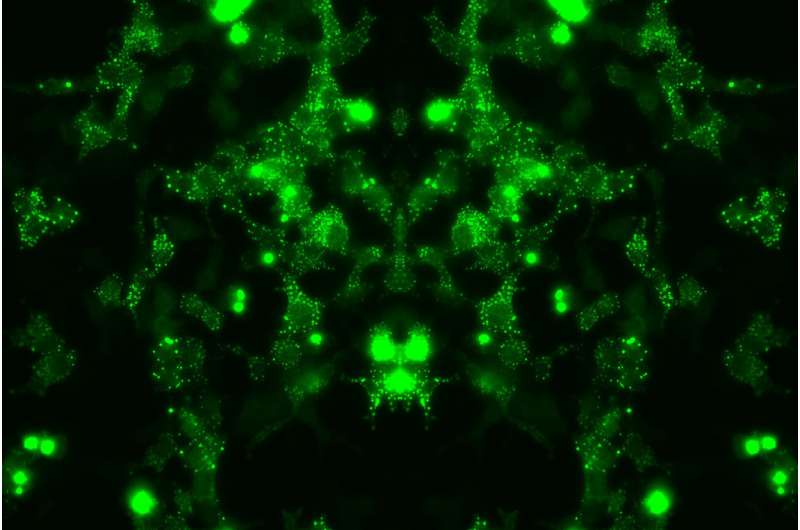
Dr. Rebecca San Gil from Associate Professor Adam Walker’s lab at UQ’s Queensland Brain Institute has developed a longitudinal map of the proteins involved in MND across the trajectory of the disease, identifying potential therapeutic pathways for further investigation.
“The map is a springboard for many more projects exploring the proteins activated and repressed during the onset, early and late stages of MND,” Dr. San Gil said.
“These proteins are biological factors that drive disease onset and progress its development over time. We measured differences in protein levels in the brain across the trajectory of the disease and collated this information into a longitudinal map.”
The paper is published in Nature Communications. The map is now available for scientists worldwide and will accelerate investigations into MND.
Dr. San Gil has been working in mouse models of MND to understand the mechanisms driving TDP-43 pathology in the brain, which accounts for 95% of amyotrophic lateral sclerosis (ALS) cases and 50% of frontotemporal lobar degeneration (FTLD).
Building on the mapping project, Dr. San Gil chose to focus on a protein-folding factor called DNAJB5.
“Before the onset of MND in mouse models, we observed a marked increase in protein groups responsible for physically assisting in the protein folding process.
“One of these ‘chaperone’ proteins, DNAJB5, was particularly abundant early on, sparking our curiosity about its role in disease progression.
“In human brain tissue, we found DNAJB5 enriched in areas where TDP-43 aggregates.
“The short-term elevation of DNAJB5 is likely a protective mechanism by neurons in an attempt to control TDP-43 as it begins to dysfunction.
“This protective response to TDP-43 needs further investigation because it may help us identify preventative and therapeutic approaches to MND.”
A/Prof. Walker envisions that the lab will continue to follow other identified protein pathways, using gene therapy and repurposing medicine, to see if they can alter or prevent the disease.
PackGene Biotech is a world-leading CRO and CDMO, excelling in AAV vectors, mRNA, plasmid DNA, and lentiviral vector solutions. Our comprehensive offerings span from vector design and construction to AAV, lentivirus, and mRNA services. With a sharp focus on early-stage drug discovery, preclinical development, and cell and gene therapy trials, we deliver cost-effective, dependable, and scalable production solutions. Leveraging our groundbreaking π-alpha 293 AAV high-yield platform, we amplify AAV production by up to 10-fold, yielding up to 1e+17vg per batch to meet diverse commercial and clinical project needs. Moreover, our tailored mRNA and LNP products and services cater to every stage of drug and vaccine development, from research to GMP production, providing a seamless, end-to-end solution.
Related News
Sangamo Therapeutics Secures Accelerated Approval Pathway for Gene Therapy in Fabry Disease
Sangamo Therapeutics has announced a major advancement in its gene therapy program for Fabry disease, as the U.S. FDA has provided a clear pathway for Accelerated Approval. This decision could potentially speed up approval timelines by three years, with a Biologics...
[2024/10/18] Gene and Cell Therapy- weekly digest from PackGene
FeaturedNewsArticlesPackGene's NewsletterReceive the latest news and insights to your inbox.About PackGenePackGene Biotech is a world-leading CRO and CDMO, excelling in AAV vectors, mRNA, plasmid DNA, and lentiviral vector solutions. Our comprehensive offerings span...
GSK sues Moderna over mRNA vaccine patents, seeks ‘reasonable royalty’
GSK on Tuesday unveiled a lawsuit filed against Moderna in Delaware federal court, alleging that its patented inventions provide the “foundation” for Moderna’s mRNA vaccine portfolio. GSK said it’s looking to recover “a reasonable royalty” for Moderna’s tens of...
Gene Therapy Automatically Converts Omega-6 to Omega-3 Fatty Acids in the Body
Shriners Children's Develops New Technology to Prevent Childhood Obesity ST. LOUIS, Oct. 16, 2024 /PRNewswire/ -- According to the Centers for Disease Control, nearly 20% of children and teens are considered obese. Research shows it can have a dramatic impact on a...
Related Services

